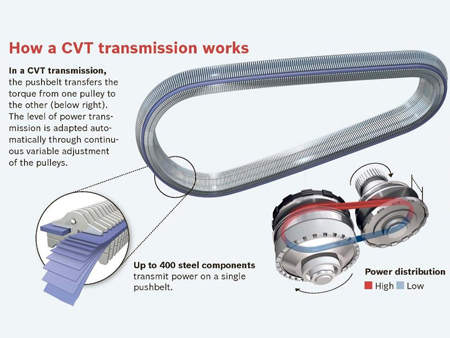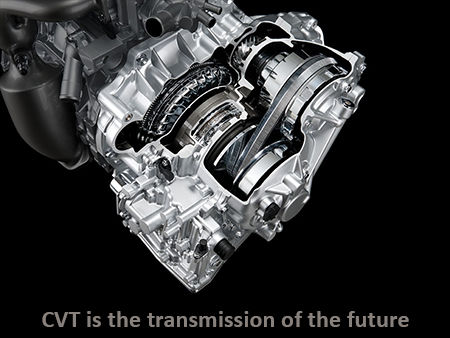Manufacturers like Nissan, Audi, Honda and Mitsubishi, just to name a few, have started to experiment with using continuously variable transmissions in their vehicles.
The question is – why? How do they work? Are these a better alternative to the conventional automatic transmission?
The traditional automatic transmission uses a set of gears to provide different ratios, or speeds. The more gears, the larger overall ratio spread. This makes for better acceleration times, quieter highway cruising and even better fuel economy. Because the CVT transmission operates without any physical gears, preferring a belt and pulley system, it has an infinite number of ratios, making it the most fuel-efficient technology under the sun right now.
HOW DOES IT WORK
As mentioned, instead of relying upon standard gears like the conventional automatic transmission does, the CVT transmission uses a system of two variable pulleys connected by a belt, a system more widely seen used by snowmobile manufacturers and that has started to trickle its way into the automobile industry.
The system consists of one pulley attached by two cups to the engine and another attached in the same manner to the transmission shaft. Both pulleys are connected by a belt made up of either a set of small chain links or thin, high strength metal slices riding on steel bands. The halves of the pulleys are moveable, coming closer together and pushing further apart, forcing the belt to ride higher or lower on the pulley. This changes the diameter of the pulleys and seamlessly varies the transmission’s ratio, creating a smoother, more efficient ride, and giving the CVT its name.
The pulley-based transmission is the most popular go-to for production vehicles. However, manufacturers have also come up with a toroidal CVT, which uses rotating disks and power rollers to replace the pulley system. A hydrostatic CVT also exists but uses pumps to regulate fluid flow and create rotational motion. It is more commonly used in heavy machinery.

How does it feel
The controls for the CVT are the same as for a conventional automatic transmission. The gas and brake pedals as well as the shift pattern remain the same, and you won’t hear or feel the transmission shift. Since it does not actually change gears, “shift shock” is lessened or eliminated entirely. Acceleration is constant and smooth, so not having the jerky clunk of changing gears to deal with is going to take some getting used to.
DISADVANTAGES
The CVT sounds like every car owner’s dream. So why hasn’t it been more widely implemented? The biggest problem with the popularity of the CVT seems to be user acceptance. While it is an amazing technology that performs well, it allows the engine to rev at any speed, so the odd sounds coming from under the hood seem to be turning some drivers away from it. To those accustomed to the traditional automatic transmission sounds, the CVT sounds a bit like a sliding transmission, or a slipping clutch – understandably disagreeable to users who aren’t familiar with the system. Also, because of the smooth function of the CVT, acceleration doesn’t have the signature lurch and sudden burst of power felt with traditional transmissions. Because of this, the vehicle feels like it is accelerating at a slower rate to some drivers, when in fact it will out-accelerate a standard automatic.
 With that being said...
With that being said...
Another issue seems to be the fear of past performance. Early model CVTs were limited as to how much horsepower they could handle (around the 100 mark), causing concerns about the long-term reliability of the modern model. Rest assured, however, that advanced technology has strengthened the system and its reliability is now comparable to conventional transmissions.
The very first CVT transmission was sketched by Leonardo DaVinci in 1490.
In 1958, DAF introduced it to the first automobile with little success. Honda began using it in the late 90’s and as technology advances, we are starting to realize that the CVT is the transmission of the future. It is already outperforming the traditional gear-based automatic transmission in the car market and we can only expect to see this technology sky rocket as it gains in popularity.
Source: albertahonda